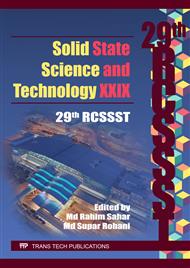p.365
p.370
p.374
p.379
p.387
p.393
p.401
p.407
p.413
Ultrasonic Bulk Waves Measurements for Defect Detection of Composite Materials
Abstract:
The defect detection in composite material is important for its quality control where the hidden defect such as crack, corrosion, notch, holes, void and porosity can develop. In this paper, the ultrasonic bulk wave measurements of longitudinal and shear waves are used to identify defect in the multilayered composite material. This study employs pulse echo technique and utilized angle beam transducer. The composite material model investigated in this contribution are made of 24 mm and 12 mm thick Aluminium plates with a width of 100 mm and a length of 203 mm which are separated with an approximately 1 mm thick oil layer. A simulated defect is created in the composite test material by drilling a hole with 2.5 mm diameter and 3 mm depth on the bottom surface of the third layer material. Finding indicates that the defect is located at 53.39 mm from transducer and the percentage difference of the defect location compared to the calculation method is 7%. It indicates that the proposed method can be use to detect defect in multilayered composite material within 10% accuracy compared to the calculation method.
Info:
Periodical:
Pages:
401-406
Citation:
Online since:
October 2017
Authors:
Price:
Сopyright:
© 2017 Trans Tech Publications Ltd. All Rights Reserved
Share:
Citation:


